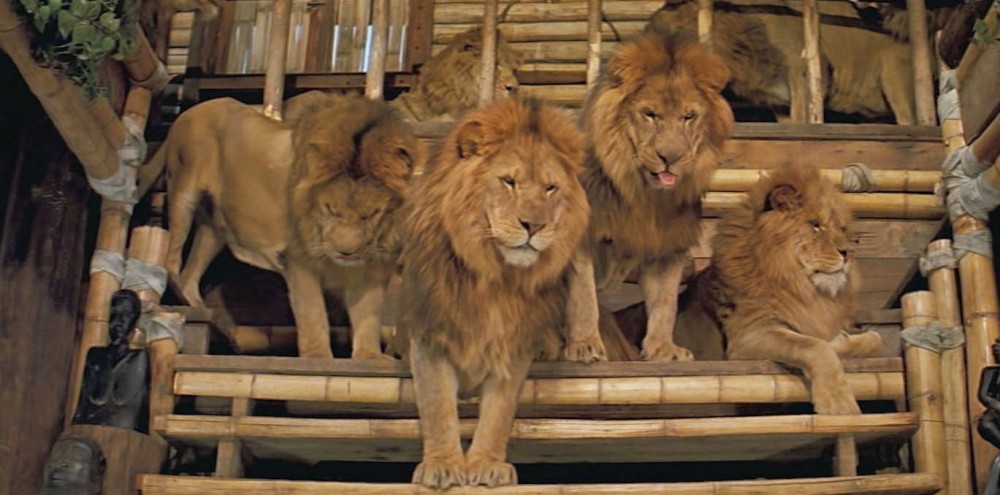
Much of the contemporary press material for Roar features, naturally, various African wildcats looking either majestic or playful, usually in the company of writer/director/star/producer Noel Marshall. The color palettes are bright, full of yellows, greens, and oranges that connote not only the animals, but the lush SoCal woodlands that stood in for a generalized Africa. But when Drafthouse Films re-released the film earlier this year, the marketing of it was markedly different: for one, the posters were in stark black and white, more fitting for a horror film or a thriller. One on these features an angry lioness mid-snarl. One has a picture of Melanie Griffith with blood streaming down her face. Most disconcerting of all is a profile picture of cinematographer Jan de Bont, the rear portion of his head shaved and covered with umpteen stitches. That said, it’s a miracle that no one got killed during principal photography, or that the film was ever completed at all. Roar, while being a rather thin anti-poaching drama, is indispensable as a cinematic monument to man’s hubris as both artists and mammals.
Marshall stars as Hank, an academic who lives in the jungle with 100-plus wild African big cats: lions, tigers, cheetahs, jaguars, leopards, and even a few liger cubs thrown in for good measure. There’s a subplot involving some rogue lions who escape the compound, and the poachers who want to take matters into their own hands, but the bulk of the film is simply Marshall’s actual literal family (sons Jack and John, stepdaughter Griffith, and wife Tippi Hedren) trying to not get mauled while Hank is away from the compound trying to round up those stray lions. That sounds glib, but let’s not forget, these are actual untrained big cats that were used for principal photography. The protective veneer of fiction is non-existent in this film. When Marshall runs away from, and then gets dogpiled by, four adult lions, it’s real. When he sticks his already-injured hand into a lion’s craw, it’s real. When an elephant bucks Hedren (which resulted in a fractured leg) and then sees fit to thoroughly gore a motorboat, it’s real. It can never become the lighthearted preservationist drama it wants to be because there’s already a nerve-eroding jungle slasher built into it by its very framework.
French director Jacques Rivette once said that every film is a documentary of its own making, and it seems particularly appropriate to apply this aphorism to Roar. The circumstances under which the film was made are so mind-boggling that it becomes nearly impossible to interpret as a piece of fiction. As indicated during the opening credits, the animals on set pretty much did as they damn well pleased, thereby throwing the pace and tone of nearly every scene out of whack. The sound design in the film is uniquely strange, ADRed to hell as if it were a spaghetti western, although this was surely done in order to camouflage the very real quivers of fear in the actors’ deliveries. However, post-production can’t edit the looks of terror in the cast’s eyes, even when they’re supposed to be characters moving a story along. That this film even bothers with character names and plot point and jokes is a testament to the level of situational denial on display. Given the environment, one where a playful frolic can suddenly morph into a tragic owning at the hands of Nature, it seems pointless to worry about the character of Madeleine hiding from a lion when you’re worried about the actress playing her.
Ultimately, it is besides the point to talk about Roar in terms of being good or bad. It completely breaks the scale since the conditions under which it was made were so extreme. What it is, and thus what it should be considered as, is a 90-minute death-defying stunt, the ne plus ultra of misguided passion projects. It takes a very specific and very potent brand of lunacy, often one driven by noble ends, to sink 11 years and $17 million into a project like this, which Marshall did. The end result, while a modestly successful piece of fiction, is the apotheosis of irresponsible filmmaking, made doubly incredible by the fact that everyone who was involved, including the director’s own flesh and blood, agreed to be so. It has been said before, but it bears repeating, it is nothing short of a miracle that no one got killed during the making of this film. It truly must be seen, not only to be believed, but just to even be conceived.
—
Roar is currently playing in limited release in the United States.
Directed by Noel Marshall; written by Noel Marshall; starring Tippi Hedren, Noel Marshall, Melanie Griffith, Jerry Marshall, John Marshall, and Kyalo Mativo; 102 minutes.



 Derek
Derek
 Isabelle
Isabelle